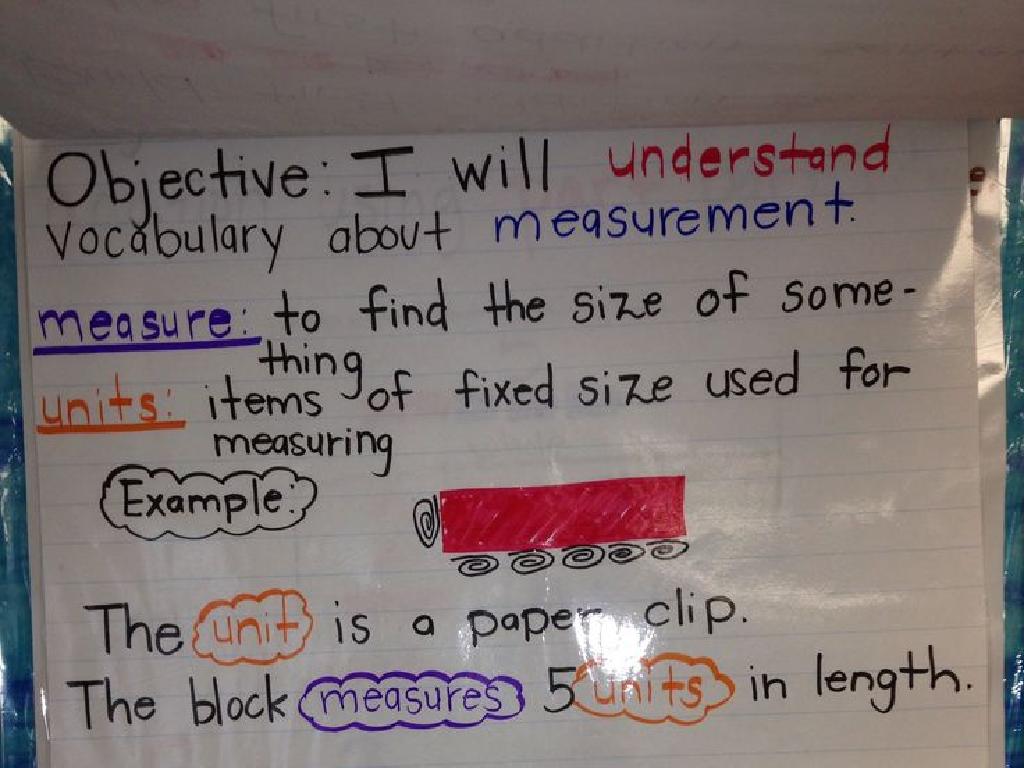Write Fractions In Lowest Terms
Subject: Math
Grade: Fourth grade
Topic: Equivalent Fractions
Please LOG IN to download the presentation. Access is available to registered users only.
View More Content
Welcome to Equivalent Fractions!
– Understanding basic fractions
– Fractions represent parts of a whole
– Exploring equivalent fractions
– Fractions with different numbers but same value
– Importance of lowest terms
– Simplifying makes math easier & clearer
– Practical uses of equivalent fractions
– Used in cooking, science, and more
|
This slide introduces the concept of equivalent fractions to fourth-grade students. Begin by explaining what fractions are, using visual aids like pie charts or pizza slices to illustrate parts of a whole. Then, move on to equivalent fractions, showing how different fractions can represent the same amount. Emphasize the importance of writing fractions in their lowest terms to simplify problems and make calculations easier. Relate the concept to real-life situations such as dividing a pizza among friends or measuring ingredients in a recipe to show practical applications. Encourage students to think of other examples where they encounter fractions.
Understanding Fractions
– A fraction represents part of a whole
– Numerator and denominator explained
– Top number is the numerator, bottom number is the denominator
– Example: 1/2 of a pizza
– 1/2 means the pizza is cut into 2 pieces, and we have 1 of them
– Simplifying fractions to lowest terms
– Divide numerator & denominator by the same number to simplify
|
Begin with the basic definition of a fraction to ensure students understand that it represents a part of a whole. Clarify the roles of the numerator and the denominator, using visual aids like a pizza to illustrate the concept. For example, if a pizza is cut into two equal parts, one part is represented as 1/2. Emphasize the importance of simplifying fractions by finding the greatest common divisor for the numerator and the denominator and dividing both by that number to get the fraction in its lowest terms. This concept is crucial for understanding equivalent fractions and will be used in future math problems.
Exploring Equivalent Fractions
– Fractions with equal value
– Example: 1/2 equals 2/4
– 1/2 is the same as 2/4 or 3/6
– Simplify fractions to lowest terms
– Divide numerator & denominator by the same number
– Practice finding equivalents
– Use objects or drawings to show equal parts
|
This slide introduces the concept of equivalent fractions, which are different fractions that represent the same value. Start by explaining that although fractions like 1/2, 2/4, and 3/6 may look different, they are actually the same when simplified. Teach students how to simplify fractions to their lowest terms by dividing both the numerator and the denominator by their greatest common divisor. Provide practice problems where students can find equivalent fractions and simplify them. Use visual aids like pie charts or fraction bars to help students better understand the concept. Encourage students to explain their thinking process when finding equivalent fractions.
Writing Fractions in Lowest Terms
– Simplify fractions to lowest terms
– Multiply or divide both parts equally
– Use the same number for numerator and denominator
– Example: Simplify 2/4 to 1/2
– Dividing both by 2 gives the simplest form
– Practice with different numbers
– Try simplifying 3/6, 4/8, 5/10
|
This slide introduces the concept of simplifying fractions to their lowest terms, which is a form of finding equivalent fractions. Emphasize that the numerator (top number) and the denominator (bottom number) must be multiplied or divided by the same non-zero number to maintain the value of the fraction. Use the example of 2/4, where both the numerator and denominator can be divided by 2 to simplify the fraction to 1/2, its lowest term. Encourage students to practice this skill with different numbers, reinforcing the concept that a fraction can be reduced to its simplest form by finding the greatest common divisor (GCD) for the numerator and denominator.
Writing Fractions in Lowest Terms
– What are lowest terms?
– Smallest numerator & denominator possible
– Find the greatest common divisor (GCD)
– GCD is the largest number that divides both
– Divide numerator & denominator by GCD
– This process simplifies the fraction
– Example: Simplify 4/8
– 4/8 divided by 4 gives us 1/2
|
When we write fractions in the lowest terms, we’re making them simpler to understand and work with. The lowest terms of a fraction have the smallest numbers possible in the numerator (top number) and denominator (bottom number) without changing the value of the fraction. To do this, we find the greatest common divisor (GCD) of both the numerator and denominator, which is the largest number that can divide both without leaving a remainder. Then, we divide both the numerator and denominator by the GCD to simplify the fraction. For example, with the fraction 4/8, the GCD is 4. When we divide both the numerator and the denominator by 4, we get the fraction 1/2, which is 4/8 in its simplest form. Encourage students to practice this process with different fractions to become comfortable with simplifying them.
Practice Time: Simplifying Fractions
– Find lowest terms for 6/9
– Determine GCD of 6 and 9
– GCD is the Greatest Common Divisor
– Divide numerator & denominator by GCD
– Simplify 6/9 by dividing both by GCD
– Discover the simplest form
– 6/9 becomes 2/3 after division
|
This slide is an interactive class activity focused on simplifying fractions. Start by explaining that the lowest terms of a fraction are found by dividing the numerator and the denominator by their greatest common divisor (GCD). Work through the example of 6/9 with the class, finding the GCD of 6 and 9, which is 3. Then, show the students how to divide both the numerator and the denominator by 3 to simplify the fraction to its lowest terms, resulting in 2/3. Encourage students to practice this method with different fractions and provide additional examples if needed. This exercise will help solidify their understanding of equivalent fractions and the concept of simplification.
Class Activity: Fraction Scavenger Hunt
– Find classroom objects for fractions
– Pair up to make equivalent fractions
– Use objects to create fractions, then find other fractions with the same value
– Present findings to the class
– Explain fractions in lowest terms
– Show how to simplify fractions to their simplest form
|
This interactive activity is designed to help students understand fractions and their equivalent forms in a fun and engaging way. Students will work in pairs to explore the classroom and find objects that can be used to represent fractions. They will then use these objects to create equivalent fractions, demonstrating their understanding of how different fractions can express the same value. Afterward, each pair will present their objects and the equivalent fractions they’ve created to the class, explaining the process they used to write these fractions in their lowest terms. The teacher should prepare by ensuring there are enough objects in the classroom to represent a variety of fractions. Additionally, the teacher should be ready to guide students through the process of simplifying fractions and provide examples if necessary. Possible activities could include using slices of apples, groups of pencils, or portions of paper to represent different fractions.
Conclusion & Homework: Mastering Fractions
– Recap: Writing fractions in lowest terms
– Why equivalent fractions matter
– They help us compare and add different fractions easily
– Homework: 5 pairs of equivalent fractions
– Find fractions that mean the same but look different
– Simplify each pair to lowest terms
– Use division to make the numerator and denominator smaller
|
As we wrap up today’s lesson, let’s remember that writing fractions in their lowest terms makes them easier to understand and work with. Equivalent fractions are important because they allow us to see that different fractions can actually represent the same value. For homework, students will find and simplify 5 pairs of equivalent fractions. This will reinforce their understanding of the concept and practice their division skills. Encourage students to look for patterns and use prime factorization to help simplify the fractions. Remind them to show all their work and check their answers by ensuring that the simplified fractions are indeed equivalent to the original ones.






